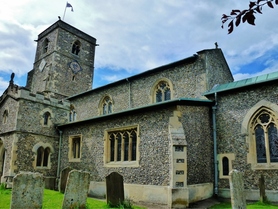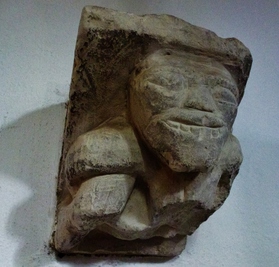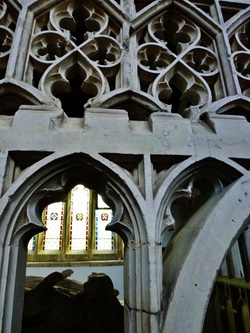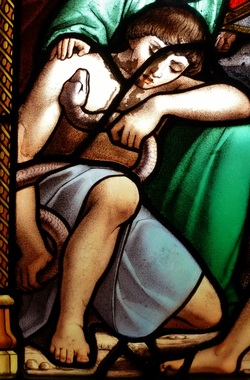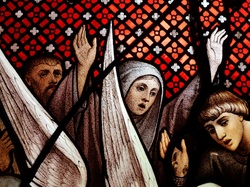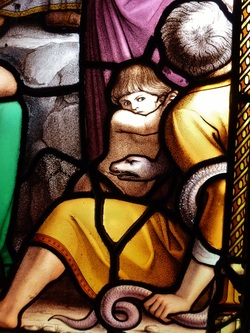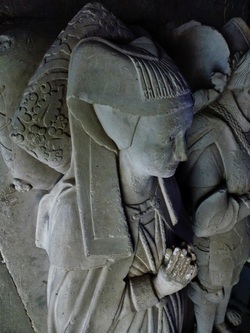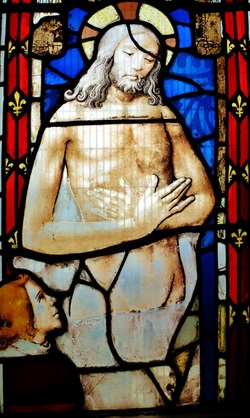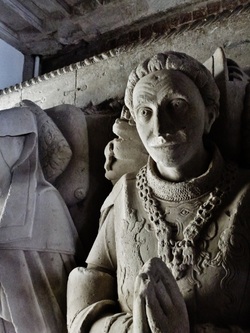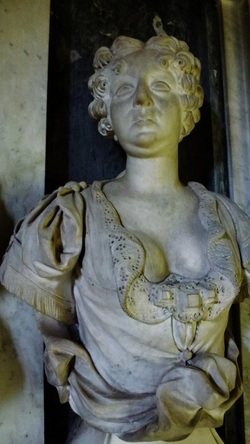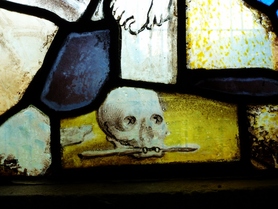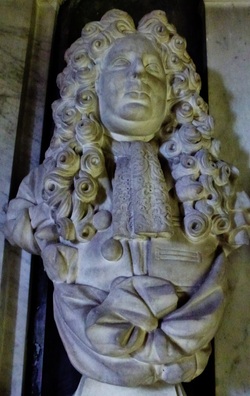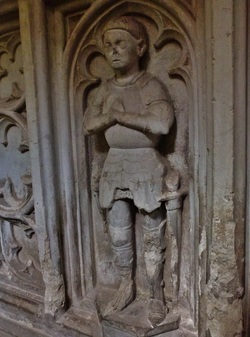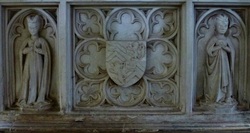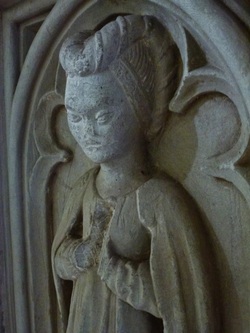St. John the Baptist, Aldbury.
Wild men and wicked women.
The road from Tring– renowned for its phantom coachman- has views unlike any other in the county as the farmed hills give way to a forested horizon. The church appears on the left as you round the bend, set back behind a lush green churchyard. Beyond the village green complete with stocks and duck pond lies the Ashridge estate, the miles of woodland hiding the sprawling gothic palace that various Wyatt architects built in the 1800s for the Earls of Bridgewater, replacing the monastic house where young Princess Elizabeth was imprisoned before gaining the throne. Up in these hills you can climb the Bridgewater column; an odd memorial to a canal building duke that peeps over the trees and looks across to the church.
The tower is tall and narrow, begun in the fourteenth century, and the church long and low. Over the chancel arch, a Nineteenth century painting of the Baptist preaching has been restored in yellow monochrome, and a very Victorian font sits under the tower. Too much tidying up has gone on during the restoration; two early Norman arches were even removed and made to conform to the rest of the arcade. The earliest remaining work is a twelfth century corbel now in the north aisle, a Romanesque grotesque known as a Sheela-na-gig, her arm passing under the leg to grasp her sexual organs in a way typical of such figures. The corbel has been damaged, probably on purpose, but was one of these once widespread figures that warned against the sins of the flesh.
Wild men and wicked women.
The road from Tring– renowned for its phantom coachman- has views unlike any other in the county as the farmed hills give way to a forested horizon. The church appears on the left as you round the bend, set back behind a lush green churchyard. Beyond the village green complete with stocks and duck pond lies the Ashridge estate, the miles of woodland hiding the sprawling gothic palace that various Wyatt architects built in the 1800s for the Earls of Bridgewater, replacing the monastic house where young Princess Elizabeth was imprisoned before gaining the throne. Up in these hills you can climb the Bridgewater column; an odd memorial to a canal building duke that peeps over the trees and looks across to the church.
The tower is tall and narrow, begun in the fourteenth century, and the church long and low. Over the chancel arch, a Nineteenth century painting of the Baptist preaching has been restored in yellow monochrome, and a very Victorian font sits under the tower. Too much tidying up has gone on during the restoration; two early Norman arches were even removed and made to conform to the rest of the arcade. The earliest remaining work is a twelfth century corbel now in the north aisle, a Romanesque grotesque known as a Sheela-na-gig, her arm passing under the leg to grasp her sexual organs in a way typical of such figures. The corbel has been damaged, probably on purpose, but was one of these once widespread figures that warned against the sins of the flesh.
The restoration of the church may not have done it many favours, but it did bring a good selection of early revival stained glass, some English, some even more colourful by Jean Capronnier of Brussels, all better than average work of the 1860s.
In the north aisle one quality window shines out in interest, being an import from the large collection of foreign glass once at Ashridge, England’s gain from Napoleonic depredations. An English canopy of the Fifteenth century and a faded virgin and child fill the head of two lights of Sixteenth century German glass; one a crucifixion with a skull biting a bone at its feet, the other a very fine Christ as the man of sorrows with a donor in the foreground.
These are not the earliest fittings to have come from Ashridge: in 1575 tiles, tombs and a screen were brought from their original home in the church of the first English college of the Bonshommes, when after the dissolution the estate became a Tudor royal nursery. The brasses on the tomb chest of Sir Ralph Verney and family of 1546 are well known, much reproduced for their ornately heraldic costumes; they are in the north east chapel, now used as a vestry, along with a fine skull and strapwork Elizabethan job to Thomas Hyde and son. On the wall of the Pendley chapel to the south are the bewigged Sir Richard Anderson and his busty wife, their gazes frozen in white marble since 1699. They look down on the tomb of Sir Robert Whittingham and his wife, surrounded by old tiles within its superb stone screen. Their effigies rest on a chest tomb carved with heraldry and mourning relatives full of character, the men in armour and the women dressed in the height of fashion. She lies in a low horned headdress, well wrapped in a cloak, whilst he wears a Lancastrian[5] SS collar and a surcoat decorated with a lion over his armour. He rests his head on a jousting helm, she on a pillow with foliate designs. The faces may have been recut, being a little vacant and doll like, but the splendid heraldic crests under their feet are finely detailed. An ordinary hind supports her, but a superb wildman of the woods lolls at his feet, bearded and covered in fur and entwined with ivy, resting his head in his hand propped up on an elbow, a ragged staff held close, all miraculously undamaged. This figure alone would make this church worth a visit, and he’s wonderfully apt in this village in the shadow of the woods.
The church is open daily, bucking the trend in this part of the county. It lies close to the centre of the village on Station Road from Tring.
The church is open daily, bucking the trend in this part of the county. It lies close to the centre of the village on Station Road from Tring.
[5] The dynastic Wars of the Roses pitted the Yorkist descendants of Edward III against their Lancastrian cousins for much of the fifteenth century.
All rights reserved for this entire site. Copyright reserved to stiffleaf for all text and images, which may not be reproduced without my permission.
